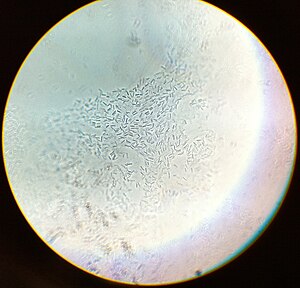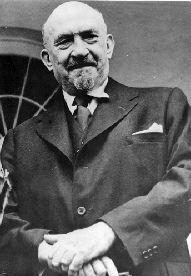Clostridium acetobutylicum
| Clostridium acetobutylicum | ||||||||||||
|---|---|---|---|---|---|---|---|---|---|---|---|---|

Clostridium acetobutylicum (unstained, phase contrast method, 1000x magnification in an oil immersion light microscope) |
||||||||||||
| Systematics | ||||||||||||
|
||||||||||||
| Scientific name | ||||||||||||
| Clostridium acetobutylicum | ||||||||||||
| McCoy et al. 1926 emend. Keis et al. 2001 |
Clostridium acetobutylicum is a bacterium belonging to the genus Clostridia , which is ofparticular biotechnological importancedue to its ability to fermentatively produce butanol and acetone .
features
Clostridium acetobutylicum is a gram-positive bacterium. Like other clostridia, this one can also move actively with the flagella arranged peritrichally on the entire bacterial surface .
The genome of the bacterium (strain ATCC 824) was completely sequenced and elucidated with the help of shotgun sequencing . It consists of a circular chromosome with 3,940,880 base pairs and a circular plasmid .
Occurrence
The bacteria live mainly in soils and sediments of water, but can also occur in many other habitats. They are also residents of the intestines ( intestinal flora ) of a number of organisms. Like most clostridia, they are classified as ubiquitous .
ecology
C. acetobutylicum lives anaerobically , so it needs an oxygen-free substrate for the formation of reproductive cells. Under aerobic conditions, it forms endospores after a few hours , which survive for several years as persistence stages even in oxygen-rich substrates and, under anaerobic conditions, become vegetative bacteria again.
metabolism
Within the clostridia, C. acetobutylicum is ecologically assigned to the saccharolytic clostridia, which are characterized by the ability to ferment carbohydrates (sugar, starch, whey). The metabolic pathway is acetone-butanol-ethanol fermentation . In addition to butanol , acetone and ethanol , the main products are butyric acid , carbon dioxide and molecular hydrogen (H 2 ). The carbohydrates are first converted into glucose and then converted into pyruvate through glycolysis . The pyruvate is then decarboxylated to acetyl-CoA via a pyruvate ferredoxin oxidoreductase , with hydrogen being formed via a hydrogenase . Acetyl-CoA is broken down into various metabolic products through reduction steps, including ethanol and, after using a thiolase via acetoacetyl-CoA, acetone, propanol, butanol and butyric acid (butyrate).
Technical importance and history
Clostridium acetobutylicum is able to ferment sugar into the solvents acetone , 1-butanol , ethanol and the organic acids acetic acid and butyric acid. Because of these properties, there is great interest in using the bacterium in industrial biotechnology for the production of these products.
The biotechnological importance was described and patented for the first time by the chemist Charles Weizmann . After the establishment of the State of Israel , Weizmann became its first President under his new name, Chaim Weizmann.
The bacterium was used for the biotic production of the organic solvents mentioned on an industrial scale until the middle of the 20th century, after which production was replaced by the more economical petrochemical synthesis from the propene fraction of crude oil .
Due to decreasing oil reserves and the associated strong fluctuations in oil prices with high points in the 1973 and 2007/2008 oil crisis , the fermentative production of butanol ( biobutanol as biofuel ) has been discussed again for several years and implemented by some companies. In addition to agricultural raw materials (sugar, starch), the use of synthesis gas for synthesis gas fermentation is increasingly being scientifically researched. The focus is on the connection of the metabolic properties of C. acetobutylicum with the usability of carbon dioxide and carbon monoxide as a carbon source. These metabolic properties, as they are present in some other clostridia (acetogenic bacteria), are used via metabolic engineering .
supporting documents
- ↑ a b c Rachel Larsen and Kit Pogliano: Clostridium acetobutylicum . in MicrobeWiki, accessed October 30, 2009.
- ↑ Nölling J, Breton G, Omelchenko MV, et al. : Genome sequence and comparative analysis of the solvent-producing bacterium Clostridium acetobutylicum . In: J. Bacteriol. . 183, No. 16, August 2001, pp. 4823-38. doi : 10.1128 / JB.183.16.4823-4838.2001 . PMID 11466286 . PMC 99537 (free full text).
- ^ Rolf D. Schmid: Pocket Atlas of Biotechnology and Genetic Engineering. 2nd edition Wiley-VCH, Weinheim 2006; Pp. 16-17. ISBN 978-3-527-31310-5 .
- ^ Charles Weizmann: Production of Acetone and Alcohol by Bacteriological Processes. U.S. Patent 1,315,585, September 1919.
